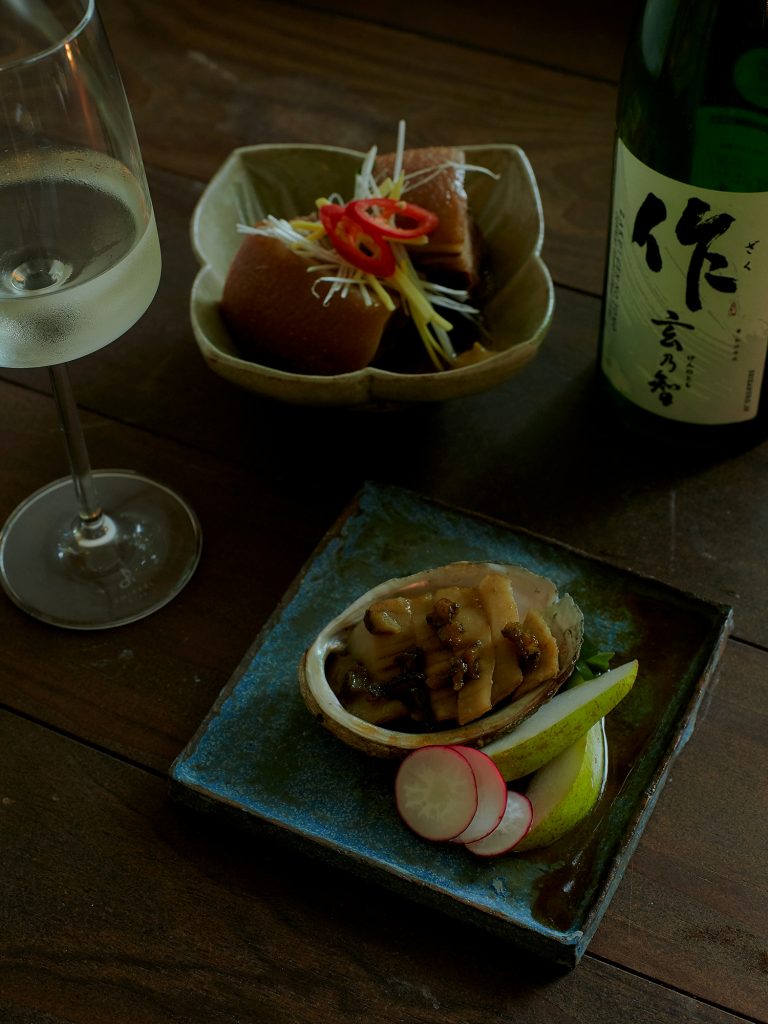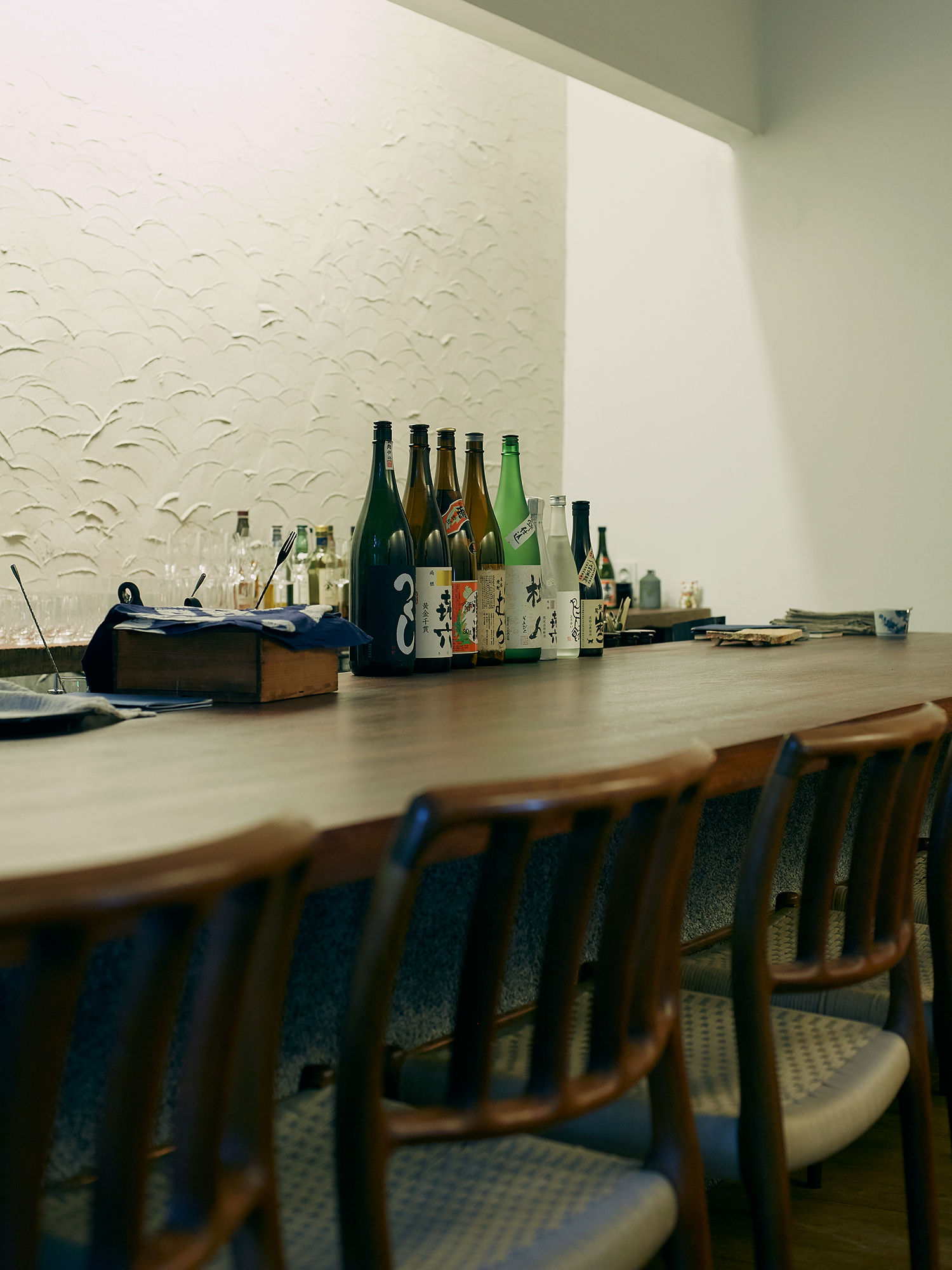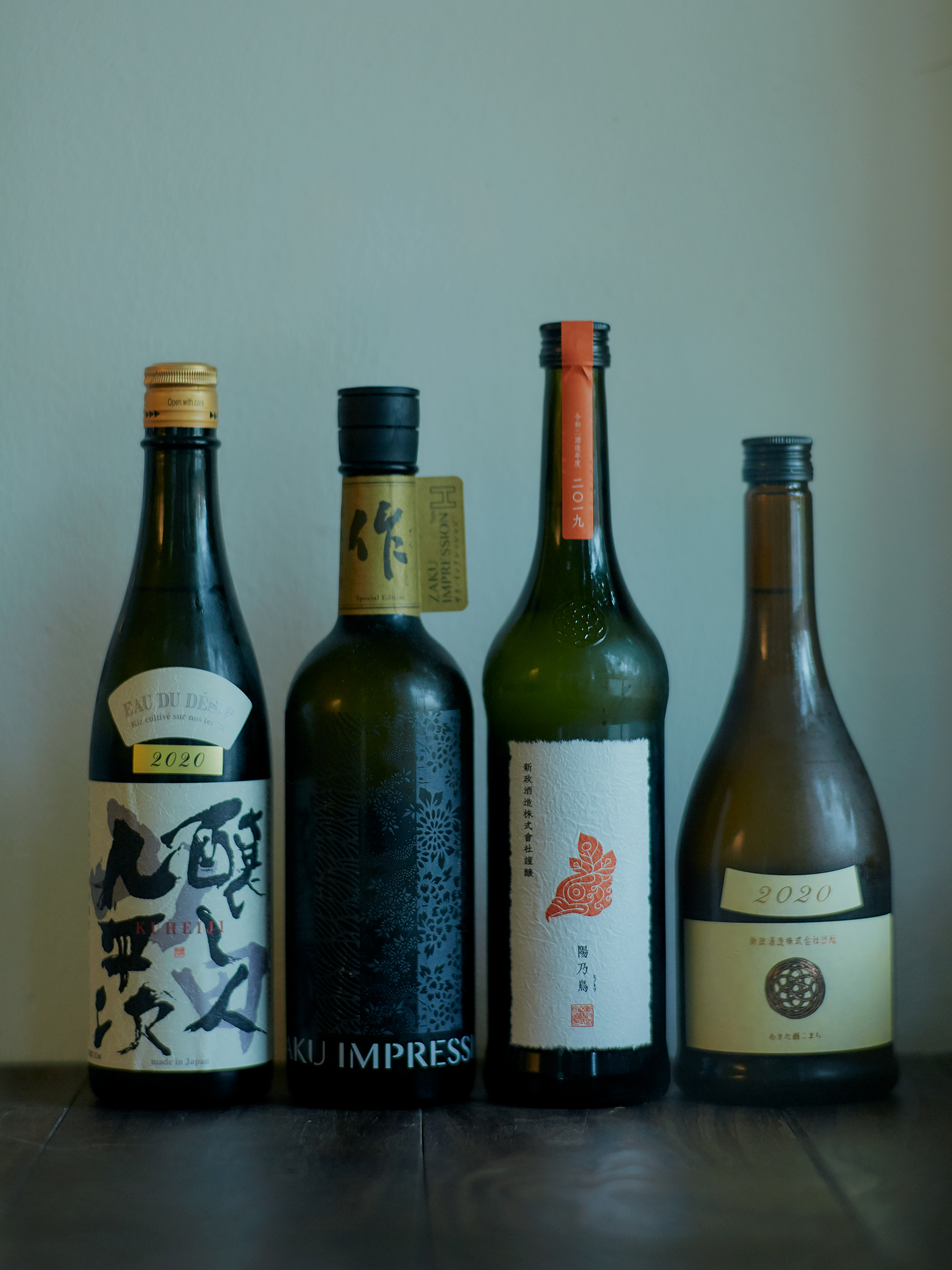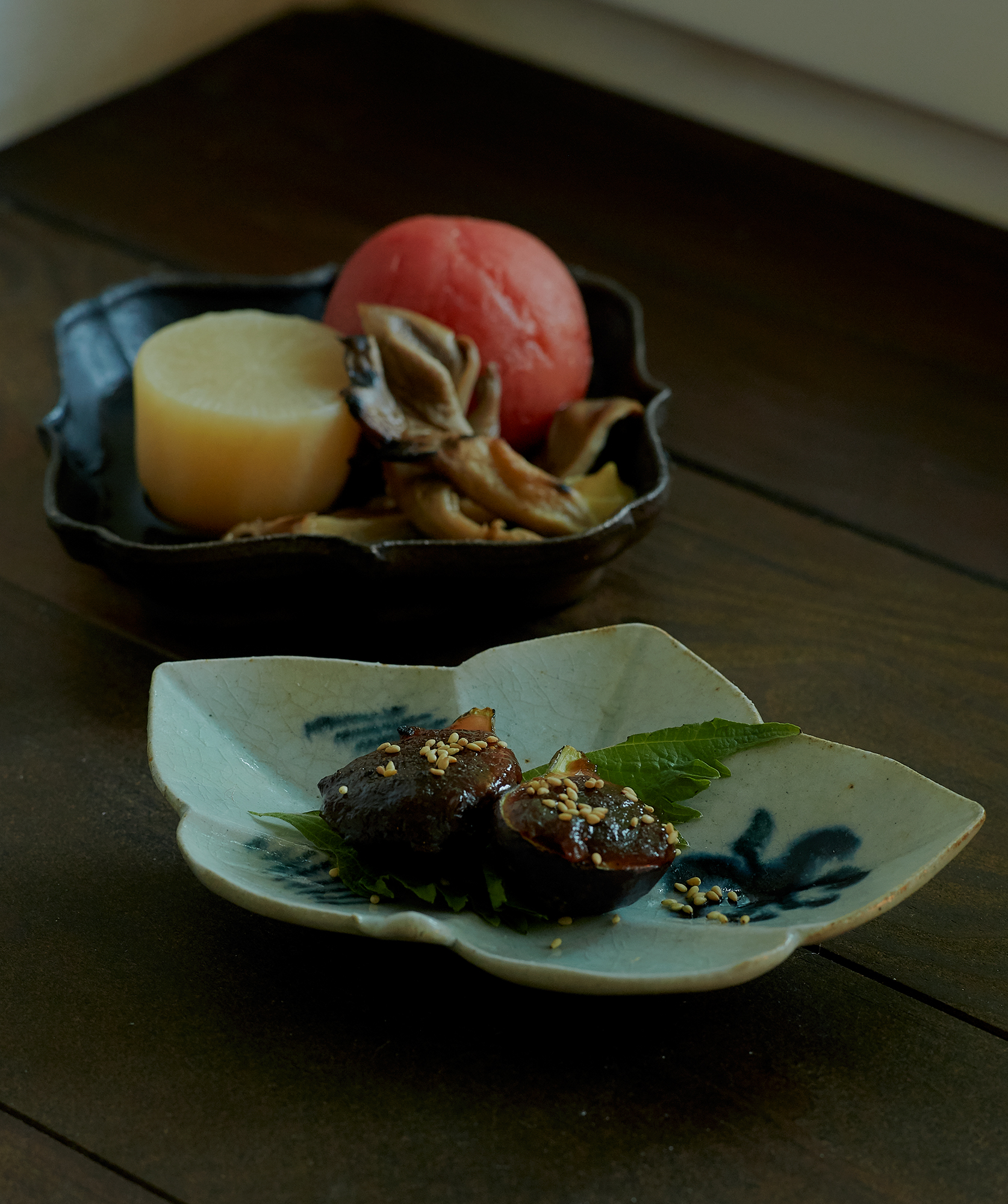
The bar’s ambiance is so welcoming that one can almost hear the Japanese greeting, “Irasshaimase.” While the bar looks small and cozy from the outside, one could sense the meticulousness and high taste level behind it. Of course, this isn’t Japan, but Berlin, Germany.
In the summer of 2020, two bars that incorporate traditional Japanese cuisine opened their doors. One of them is s h i z u k u., located in Kreuzkölln, the intersection of Neukölln and Kreuzberg in southeast Berlin. The bar offers rare sake and shochu that one can’t find anywhere else, intricate, elegant dishes that’ll surprise even the most refined Japanese palates, and a warm atmosphere that makes one forget about the precarious world outside.
Within Berlin’s dining culture, it’s been said that a place where cool people frequent is better than a place with a Michelin star. Recently, however, things have been heading in a more orthodox direction. Asian fusion restaurants with a wide array of influences might be declining. We dove into Berlin’s changing gastronomy and the bars that have been gaining attention right off the bat.

Once one leaves the hustle and bustle of the station square filled with different cultures, one should head for the vast 50-hectare Hasenheise Park. Popular restaurants line up on the other side of the street, and in one corner is an unassuming and elegant bar. When one goes through the entrance at the end of an open, wooden terrace scattered with fall leaves, one will find a calm ambiance with white and dark blue colors. There’s no sign out front. We spoke with Atsushi Shimizu, the owner of s h i z u k u., which is already garnering attention as a hideout in Berlin.

Wanting to open a bar where a customer can come alone and drink while reading a book; just like in Japan
–How did s h i z u k u. come about?
Atsushi Shimizu: This used to be a Japanese tea cafe called Macha-Macha. I was a staff there, and when it was going to close down, the owner asked me if I wanted to try something out. I wanted to open my bar for a long time and already had the idea of opening a bar that served shochu and Japanese tea. So, I suggested that. I wanted to run a small, hideout-like bar, which is common in Japan, with just a countertop and serve high-quality drinks and some sensible dishes. The opportunity came to me just when I discussed this idea with people I knew.
–Your bar is on the main street, but it’s tucked away and doesn’t have a sign. I agree that hideout is the appropriate description. This sort of style is quite rare in Berlin, yes?
Shimizu: The first concept I had was “A bar that one could easily find in Japan.” Many bars in Tokyo have a welcoming atmosphere where one can enter alone without hesitation. But in Berlin, or other foreign countries for that matter, they’re hard to find. That’s why I wanted to recreate that. I wanted to provide a space where people could come alone, read a book while drinking, and eat with no rush.
–You mean it’s not only Japanese people who want to drink slowly and leisurely by themselves without being bothered by anyone?
Shimizu: The culture of doing things alone “ohitorisama” isn’t only rooted in Japan, but also in Germany, Australia, Korea, and so on, regardless of race. I realized people do come by themselves and that there’s a demand for it. At first, I was still trying to figure out how to run a hideout, which isn’t widespread in Berlin, in the Kreuzkölln area. But as of late, I’ve come to understand the target demographic.

–From the moment I entered s h i z u k u., I felt comfortable and at ease. Was the interior design your idea? The overall ambiance has a contemporary Japanese feel, while the countertop chairs have a modern Western style.
Shimizu: Yes. I consulted with an interior designer to create the store design and concept. The countertop chairs have a mid-century Danish design. I also have a similar antique chair at home, but antique furniture from Scandinavia has thin and delicate legs, so not many are in good condition. These chairs are in good condition and are valuable.
–You know a lot about interior design. Did you specialize in it in school?
Shimizu: I just have a lot of curiosity. I’ve loved music since middle school and would go out of my way to order and collect zines and tapes from the U.S. Also, I’ve always been interested in art, food, and fashion. After studying French literature in university, I went to Esmod Japon in Kansai to study fashion. Although it closed down, there used to be an Esmod Berlin, and I came to Berlin as an exchange student.
–I didn’t know that there was an Esmod in Berlin! Berlin then must’ve been different from today.
Shimizu: It was as you’d expect in the 90s; it was wild. The clubs and parties were fun, and although they’re from London, magazines like i-D and The Face were very stylish back then. Second-hand clothes, antiques, and the cost of living were cheaper than now.
–I’m jealous you got to experience Berlin in those days. It seems like the culture of music, fashion, and art from the 90s and such inform your sensibilities. How do you choose the alcohol you serve, which I’m sure has to do with choosing shochu and sake? You’ve been reimporting natural wines from Japan recently.
Shimizu: This is obvious, but the quality of the taste and whether the bottle design matches the bar’s image are vital factors in my selection. Sake is already well-known in Germany, and I think there’s still so much potential there. In this way, the shochu market may still be nascent. Shochu is made by fermenting raw ingredients with koji and is distilled only once. So you can enjoy the condensed taste of the ingredients in comparison to other alcohols. I also carry a rare, unfiltered shochu called Kiroku in my bar.
–Could you give some recommendations for each type of alcohol?
Shimizu: The Kiroku sweet potato shochu and the premium barley shochu, Hyakunen no Kodoku, are popular among the regulars. For sake, EAU DU DÉSIR 2020 from Kamoshibito Kuheiji and Zaku IMPRESSION H are popular. For natural wine, I recommend Arancia, 100% Delaware, from Fattoria AL FIORE, and Amphora Aranchione from Grape Republic, vinified in a terracotta pot. All of these will make you want to drink them again.


–You import natural wine from Japan, but do they have something that European wines don’t?
Shimizu: There are many prominent wineries in Japan. Of course, the taste quality is high, but I also like the bottle designs. Right now, I especially recommend orange wine.
Compared to natural wines from Europe, Japanese natural wines have gentler yeast and acidity, making them smoother and easier to drink. The grapes used in such wines are from Delaware, Steuben, Koshu, and such, which aren’t in Europe, so they have a flamboyant aroma and flavor that European wines don’t have. Some wines subtly accompany a meal or taste like a light cocktail; you can enjoy a wide array of wines depending on your mood and the occasion.

–I’m sure covid had played a part in this, but there was no prior information about the opening of s h i z u k u. The bar had opened before I knew it. I learned about it from my friends. I heard that you didn’t promote the bar loudly and that it mostly spread by word of mouth. Was this a deliberate choice?
Shimizu: Yes, it was. I don’t post pictures of the bar or the menu on Instagram, just product images. In my view, the best way to become known is through organic connections like word of mouth. It’s probably a worldwide trend in gastronomy, but there’s too much focus on making customers excited before they come to the restaurant by creating colorful dishes and ambiances. Sadly, the norm is to let them go home feeling the same as they did when they walked in.
Many bars are loud and aggressive. If I go to a bar in a 5-star hotel, I feel like I have to wear Gucci or Balenciaga and be luxurious. I want to prioritize this easy-going feeling, where people could casually come and go. The most valuable thing is to make people want to come back.
–When I saw the Instagram page for s h i z u k u., I felt like there was no information, but it did make me visualize the place. It’s like you convey the image of s h i z u k u. through a gallery.
Shimizu: This is especially true for sake, shochu, and wine: each has its backstory and history. I want customers who come to s h i z u k u. to feel that, and I’d be happy if they drank sake with an imaginative and curious mind.

The photos on s h i z u k u.’s Instagram page are taken by Shimizu himself. Inside the bar, haruka nakamura’s music softly played in the background; it made me emotional and want to say, “I’m home.” Next up is NOMU Sake Bar, in vol. II.
s h i z u k u.
Address: Hasenheide 16, 10967 Berlin
Opening hours: 6:30 pm to 2:00 am
Holidays: Monday, Tuesday, and Wednesday
Atsushi Shimizu
After studying French literature and fashion, Atsushi Shimizu entered the world of gastronomy in Japan. Afterward, he moved to Germany and interned at Demeter. After working in various types of restaurants, Shimizu opened s h i z u k u. in 2020. He strives to run a small store akin to a hideout for adults.
Photography: Hinata Ishizawa
Translation Lena Grace Suda

